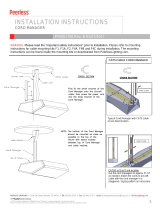Installing IP500/IP500 V2 Page 8
15-601042 Issue 28c (19 August 2013)IP Office 9.0
............................................................................ 31710.11.36 5410
............................................................................ 31810.11.37 5420
............................................................................ 31910.11.38 5601
............................................................................ 32010.11.39 5602
............................................................................ 32110.11.40 5610
............................................................................ 32210.11.41 5620
............................................................................ 32310.11.42 5621
............................................................................ 32410.11.43 9504
............................................................................ 32510.11.44 9508
............................................................................ 32610.11.45 9608
............................................................................ 32710.11.46 9611G
............................................................................ 32810.11.47 9620L, 9620C
............................................................................ 33010.11.48 9621G
............................................................................ 33110.11.49 9630G
............................................................................ 33310.11.50 9640, 9640G
............................................................................ 33510.11.51 9641G
............................................................................ 33610.11.52 9650, 9650C
............................................................................ 33810.11.53 Audio Conferencing Unit
............................................................................ 33910.11.54 ETR 6, ETR 6D
............................................................................ 34010.11.55 D100 Series
............................................................................ 34110.11.56 ETR 18, ETR 18D
............................................................................ 34210.11.57 ETR 34D
............................................................................ 34310.11.58 M7100
............................................................................ 34310.11.59 M7100N
............................................................................ 34410.11.60 M7208
............................................................................ 34410.11.61 M7208N
............................................................................ 34510.11.62 M7310
............................................................................ 34510.11.63 M7310N
............................................................................ 34610.11.64 M7324
............................................................................ 34610.11.65 M7324N
............................................................................ 34710.11.66 T7000
............................................................................ 34710.11.67 T7100
............................................................................ 34810.11.68 T7208
............................................................................ 34910.11.69 T7316
............................................................................ 35010.11.70 T7316E
............................................................................ 35110.11.71 T7406, T7406e
............................................................................ 35210.11.72 T3 Classic
............................................................................ 35310.11.73 T3 Comfort
............................................................................ 35410.11.74 T3 Compact
..................................................................... 35510.12 Phone Add-Ons
............................................................................ 35610.12.1 201B RIM
............................................................................ 35710.12.2 4450
............................................................................ 35810.12.3 BM32
............................................................................ 35910.12.4 DBM32
............................................................................ 36010.12.5 EU24
............................................................................ 36110.12.6 EU24BL
............................................................................ 36210.12.7 KLM Module
............................................................................ 36310.12.8 SMB24
............................................................................ 36410.12.9 T3 DSS
............................................................................ 36510.12.10 T7316e KEM
............................................................................ 36610.12.11 XM24
..................................................................... 36710.13 Ancilliary Systems
............................................................................ 36710.13.1 Digitial Mobility Solution
............................................................................ 36810.13.2 DECT R4
..................................................................... 36910.14 Applications
............................................................................ 37010.14.1 IP Office Application Server
............................................................................ 37110.14.2 ContactStore
............................................................................ 37210.14.3 Customer Call Reporter
............................................................................ 37310.14.4 IP Office Manager
............................................................................ 37410.14.5 Monitor
............................................................................ 37510.14.6 one-X Portal for IP Office
............................................................................ 37610.14.7 Flare Experience for IP Office
............................................................................ 37810.14.8 SoftConsole
............................................................................ 37910.14.9 IP Office Video SoftPhone
............................................................................ 38010.14.10 System Status Application
............................................................................ 38110.14.11 TAPI
............................................................................ 38210.14.12 Voicemail Pro
............................................................................ 38410.14.13 Single Windows Server Support
............................................................................ 38410.14.14 IP Office Ports
............................................................................ 38510.14.15 Operating System Summary
..................................................................... 38710.15 Physical Ports
............................................................................ 38810.15.1 Cables
............................................................................ 39010.15.2 ANALOG Port
............................................................................ 39010.15.3 AUDIO Port
............................................................................ 39110.15.4 BRI Port (So)
............................................................................ 39210.15.5 BRI Port (To)
............................................................................ 39310.15.6 DC I/P Port
............................................................................ 39310.15.7 DS Ports (RJ45)
............................................................................ 39410.15.8 EF Port
............................................................................ 39410.15.9 ETR Port
............................................................................ 39510.15.10 EXPANSION Port
............................................................................ 39510.15.11 EXT O/P Port
............................................................................ 39610.15.12 LAN Port
............................................................................ 39710.15.13 PF Port
............................................................................ 39810.15.14 PHONE (POT) Port
............................................................................ 39910.15.15 PRI Port
............................................................................ 40010.15.16 RS232 Port (DTE)
............................................................................ 40110.15.17 TCM Port (RJ21)
............................................................................ 40110.15.18 TCM Port (RJ45)
..................................................................... 40210.16 Licences
............................................................................ 40310.16.1 System Edition Licenses
............................................................................ 40410.16.2 Upgrade Licenses
............................................................................ 40510.16.3 Trunk Licensing
............................................................................ 40610.16.4 Telephone/Endpoint Licenses
............................................................................ 40710.16.5 User Licenses
............................................................................ 41010.16.6 Voicemail Pro Licenses
............................................................................ 41210.16.7 Customer Call Reporter Licenses
............................................................................ 41310.16.8 Trial Licenses
............................................................................ 41410.16.9 CTI Licenses
............................................................................ 41410.16.10 Other Licenses
..................................................................... 41510.17 Hardware Software Compatibility
..................................................................... 42110.18 Hardware PCS Levels
..................................................................... 42110.19 TAA
Safety Statements11.
..................................................................... 42411.1 Lithium Batteries
..................................................................... 42411.2 Lightning Protection/Hazard Symbols
..................................................................... 42511.3 Trunk Interface Modules
..................................................................... 42611.4 Further Information and Product Updates
..................................................................... 42611.5 Port Safety Classification
..................................................................... 42711.6 EMC Directive
..................................................................... 42811.7 Regulatory Instructions for Use
............................................................................ 42811.7.1 Australia
............................................................................ 42811.7.2 Canada
............................................................................ 42911.7.3 China
............................................................................ 43011.7.4 European Union





















